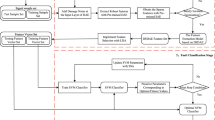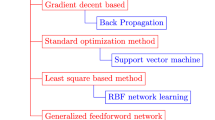Abstract
Fault diagnosis of analog circuit is critical to improve safety and reliability in electrical systems and reduce losses. Traditional fault diagnosis methods of analog circuit usually rely on the hand design feature extractor and can not generalize well to other diagnosis domains. To address these issues, an end-to-end denoising autoencoder (EEDAE)-based fault diagnosis approach is proposed. The proposed approach includes denoising autoencoder (DAE) and a softmax classifier. The DAE is designed to automatically extract fault features from the raw time series signals without any signal processing techniques and diagnostic expertise, and then the softmax classifier is used to classify the fault mode of analog circuits. Specifically, we design a novel loss function by jointly minimizing reconstruction loss and classification loss to improve training efficiency. The proposed approach just has one training stage, in which the encoder, decoder, and classifier are trained simultaneously. The experimental results demonstrate that compared with traditional methods, the proposed method has higher accuracy and lower requirements on data.










Similar content being viewed by others
Code availability
The code in this study can be downloaded from https://github.com/yangtriple/analog-circuit-fault-diagnosis-based-on-deep-autoencoder-
References
Liu, Z. B., Liu, T. M., Han, J. W., Bu, S. H., Tang, X. J., & Pecht, M. (2016). Signal model-based fault coding for diagnostics and prognostics of analog electronic circuits. IEEE Transactions on Industrial Electronics, 46(1), 605–614. https://doi.org/10.1109/TIE.2016.2599142
Tadeusiewicz, M., & Halgas, S. (2017). A method for local parametric fault diagnosis of a broad class of analog integrated circuits. IEEE Transactions Instrumentation and Measurement, 67(2), 328–337. https://doi.org/10.1109/TIM.2017.2775438
Cui, J., & Wang, Y. R. (2011). A novel approach of analog circuit fault diagnosis using support vector machines classifier. Measurement, 44(1), 281–289. https://doi.org/10.1016/j.measurement.2010.10.004
Gao, T. Y., Yang, J. L., Jiang, S. D., & Yang, C. (2019). A novel fault diagnostic method for analog circuits using frequency response features. Review of Scientific Instruments, 90(10), 104708-1-104708–11. https://doi.org/10.1063/1.5120560
Vasan, A. S. S., Long, B., & Pecht, M. (2013). Diagnostics and prognostics method for analog electronic circuits. IEEE Transactions on Industrial Electronics, 60(11), 5277–5291. https://doi.org/10.1109/TIE.2012.2224074
Long, B., Li, M., Wang, H. J., & Tian, S. L. (2013). Diagnostics of analog circuits based on LS-SVM using time-domain features. Circuits, Systems, and Signal Processing, 32(6), 2683–2706. https://doi.org/10.1007/s00034-013-9614-3
Xie, Y. L., Li, X. F., Xie, S. S., Xie, X., & Zhou, Q. Z. (2014). Soft fault diagnosis of analog circuits via frequency response function measurements. Journal of Electronic Testing, 30(2), 243–249. https://doi.org/10.1007/s10836-014-5445-9
He, W., He, Y. G., Li, B., & Zhang, C. L. (2019). Feature extraction of analogue circuit fault signals via cross-wavelet transform and variational Bayesian matrix factorization. IET Science, Measurement & Technology, 13(2), 318–327. https://doi.org/10.1049/iet-smt.2018.5432
Zhang, Z., Duan, Z., Long, Y., & Yuan, L. (2014). A new swarm-SVM-based fault diagnosis approach for switched current circuit by using kurtosis and entropy as a preprocessor. Analog Integrated Circuits and Signal Processing, 81(1), 289–297. https://doi.org/10.1049/iet-smt.2018.5432
Yuan, L. F., He, Y. G., Huang, J. Y., & Sun, Y. C. (2010). A new neural-network-based faultdiagnosis approach for analog circuits by using kurtosis and entropy as apreprocessor. IEEE Transactions on Instrumentation and Measurement, 59(3), 586–595. https://doi.org/10.1109/TIM.2009.2025068
Song, P., He, Y., & Cui, W. (2016). Statistical property feature extraction based on FRFT for fault diagnosis of analog circuits. Analog Integrated Circuits and Signal Processing, 87, 427–436. https://doi.org/10.1007/s10470-016-0721-5
Xiao, Y. Q., & Feng, L. G. (2011). A novel linear ridgelet network approach for analog fault diagnosis using wavelet-based fractal analysis and kernel PCA as preprocessors. Measurement, 45(3), 297–310. https://doi.org/10.1016/j.measurement.2011.11.018
Arabi, A., Bourouba, N., Belaout, A., & Ayad, M. (2018). An accurate classifier based on adaptive neuro-fuzzy and features selection techniques for fault classification in analog circuits. Integration, the VLSI Journal, 64, 50–59. https://doi.org/10.1016/j.vlsi.2018.08.001
Heydarzadeh, M., & Nourani, M. (2016). A two-stage fault detection and isolation platform for industrial systems using residual evaluation. IEEE Transactions on Instrumentation and Measurement, 65(10), 2424–2432. https://doi.org/10.1109/TIM.2016.2575179
Chen, P., Yuan, L. F., He, Y. G., & Luo, S. (2016). An improved SVM classifier based on double chains quantum genetic algorithm and its application in analogue circuit diagnosis. Neurocomputing, 211, 202–211. https://doi.org/10.1016/j.neucom.2015.12.131
Cui, J., & Wang, Y. R. (2010). A novel approach of analog fault classification using a support vector machines classifier. Metrology and Measurement Systems, 17(4), 561–581. https://doi.org/10.2478/v10178-010-0046-0
Aminian, F., Aminian, M., & Collins, H. W. (2002). Analog fault diagnosis of actual circuits using neural networks. IEEE Transactions on Instrumentation and Measurement, 51(3), 544–550. https://doi.org/10.1109/TIM.2002.1017726
Aminian, M., & Aminian, F. (2007). A modular fault-diagnostic system for analog electronic circuits using neural networks with wavelet transform as a preprocessor. IEEE Transactions on Instrumentation and Measurement, 56(5), 1546–1554. https://doi.org/10.1109/TIM.2007.904549
Binu, D., & Kariyappa, B. (2019). RideNN: A new rider optimization algorithm-based neural network for fault diagnosis in analog circuits. IEEE Transactions on Instrumentation and Measurement, 68(1), 2–26. https://doi.org/10.1109/TIM.2018.2836058
Yu, W. X., Sui, Y. B., & Wang, J. N. (2016). The faults diagnostic analysis for analog circuit based on FA-TM-ELM. Journal of Electronic Testing, 32, 459–465. https://doi.org/10.1007/s10836-016-5597-x
Gan, X. S., Qu, H., Meng, X. W., Wang, C. L., & Zhu, J. (2019). Research on ELM soft fault diagnosis of analog circuit based on KSLPP feature extraction. IEEE Access, 7, 92517–92527. https://doi.org/10.1109/ACCESS.2019.2923242
Luo, H., Lu, W., Wang, Y. R., Wang, L., & Zhao, X. L. (2016). A novel approach for analog fault diagnosis based on stochastic signal analysis and improved GHMM. Measurement, 81, 26–35. https://doi.org/10.1016/j.measurement.2015.11.041
Zhao, G. Q., Liu, X. Y., Zhang, B., Liu, Y. F., Niu, G. X., & Hu, C. (2018). A novel approach for analog circuit fault diagnosis based on deep belief network. Measurement, 121, 170–178. https://doi.org/10.1016/j.measure-ment.2018.02.044
Zhao, G. Q., Han, X., Teng, W. Y., Yang, X. Z., & Hu, C. (2019). Analog circuit incipient fault diagnosis using deep neural Network. In 2019 14th IEEE international conference on electronic measurement & instruments (ICEMI) (pp. 1294–1302). https://doi.org/10.1109/ICEMI46757.2019.9101841.
Pulgar, F. J., Charter, F., Rivera, A. J., & Del Jesus, M. J. (2019). Choosing the proper autoencoder for feature fusion based on data complexity and classifiers: Analysis, tips and guidelines. Information Fusion, 54, 44–60. https://doi.org/10.1016/j.inffus.2019.07.004
Vincent, P., Larochelle, H., Bengio, Y., & Manzagol, P. A. (2008). Extracting and composing robust features with denoising autoencoders. In Proceedings of the 25th international conference on machine learning (pp. 1096–1103). https://doi.org/10.1145/1390156.1390294.
Sun, M. D., Wang, H., Liu, P., Huang, S. D., & Fan, P. (2019). A sparse stacked denoising autoencoder with optimized transfer learning applied to the fault diagnosis of rolling bearings. Measurement, 146, 305–314. https://doi.org/10.1016/j.measurement.2019.06.029
Sun, W. J., Shao, S. Y., Zhao, R., Yan, R. Q., & Zhang, X. W. (2016). A sparse auto-encoder-based deep neural network approach for induction motor faults classification. Measurement, 89, 171–178. https://doi.org/10.1016/j.measurement.2016.04.007
Zhang, C. L., He, Y. G., Yuan, L. F., He, W., Xiang, S., & Li, Z. G. (2016). A novel approach for diagnosis of analog circuit fault by using GMKL-SVM and PSO. Journal of Electronic Testing, 32, 531–540. https://doi.org/10.1007/s10836-016-5616-y
Maaten, L. V. D., & Hinton, G. (2008). Visualizing data using t-SNE. Journal of Machine Learning Research, 9, 2579–2605. https://doi.org/10.1007/s10846-008-9235-4
Funding
This work was supported in part by the Science and Technology Research and Development Program of China National Railway Corporation Limited under Grant N2020J007.
Author information
Authors and Affiliations
Contributions
YY designed the study and wrote the paper; LW contributed significantly to analysis and manuscript preparation; HC and CW help perform the analysis with constructive discussions.
Corresponding author
Ethics declarations
Conflict of interest
The authors declare that they have no conflict of interest regarding the publication of this article.
Availability of data and material
All data in this study can be obtained by simulation experiments.
Additional information
Publisher's Note
Springer Nature remains neutral with regard to jurisdictional claims in published maps and institutional affiliations.
Rights and permissions
About this article
Cite this article
Yang, Y., Wang, L., Chen, H. et al. An end-to-end denoising autoencoder-based deep neural network approach for fault diagnosis of analog circuit. Analog Integr Circ Sig Process 107, 605–616 (2021). https://doi.org/10.1007/s10470-021-01835-w
Received:
Revised:
Accepted:
Published:
Issue Date:
DOI: https://doi.org/10.1007/s10470-021-01835-w




